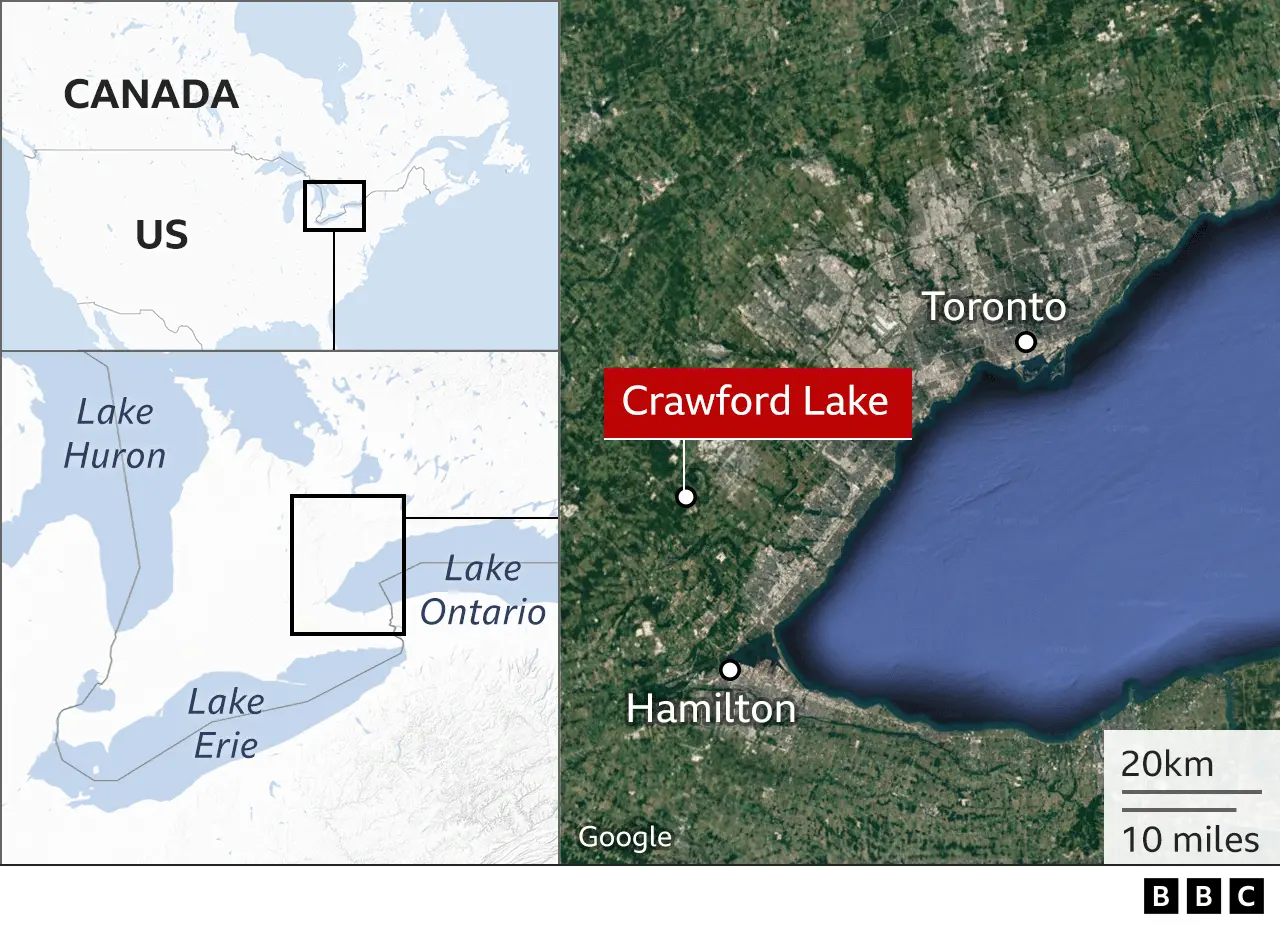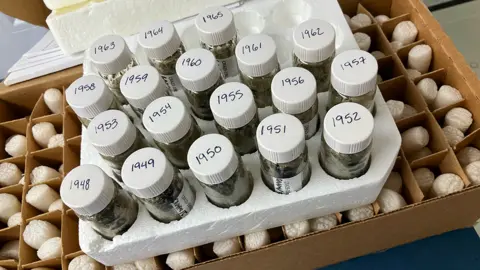The Anthropocene: Canadian lake mud 'symbolic of human changes to Earth'

 CONSERVATION HALTON
CONSERVATION HALTONCrawford Lake, a small body of water in Ontario, Canada, is being put forward as the location that best records humanity's impacts on Earth.
Scientists are trying to define a new geological time period to recognise the changes we've made to the planet, and Crawford is their model example.
Its sediments have captured fallout from intense fossil fuel burning, and even the plutonium from bomb tests.
The muds would be symbolic of the onset of a proposed Anthropocene Epoch.
Researchers want to acknowledge their significance by making them a "golden spike", or more properly a Global Boundary Stratotype Section and Point.
Other great transitions in geological time are associated with a GSSP. Often, it's literally a brass nail hammered into some cliff face deemed to be of major scientific importance.
But for Crawford, it would be a brass plaque next to a frozen section of the sediments, kept in a museum in the Canadian capital, Ottawa.
"Crawford is just brilliant for this," explained Dr Simon Turner from University College London.
"A core from its bottom muds looks like a massive dirty lollipop, but it contains these beautiful, annually laminated sediments.
"Those annual layers record fossil fuel combustion products, plutonium, changes in geochemistry, changes in micro-ecology - all the sorts of things that chart environmental change," the secretary to the Anthropocene Working Group (AWG) told BBC News.
 USDE
USDEYou may have seen the famous Chronostratigraphic Chart featured in textbooks and on school classroom walls, detailing the 4.6-billion-year history of Earth.
Its blocks of time - like Triassic, Jurassic and Cretaceous - trip off the tongue.
We currently live in the Holocene Epoch, which covers the time from the end of the last ice age, 11,700 years ago.
 F.MCCARTHY/BROCK UNIVERSITY
F.MCCARTHY/BROCK UNIVERSITYIt's been the job of the AWG for the past decade to try to establish whether or not the chart should be updated.
On this question, the AWG is convinced the case has been made. A formal start date has also been identified - the 1950s.
This decade marks the beginning of the "Great Acceleration", when the human population and its consumption patterns suddenly speeded up. It coincides with the spread of ubiquitous "techno materials", such as aluminium, concrete and plastic.
In Crawford's sediments, scientists are able to detect the quickening, year on year.

In warm summer months, the growth of algae prompts the lake water to produce tiny chalk crystals (calcite) that fall to the lake bottom as a white layer; in cold winter months, the algae and other organisms die back and their organic matter settles out as a brown/black layer.
But captured within these light-dark bands are the broader environmental changes around the lake.
It's almost as if the scientists are reading a barcode at a supermarket check-out.
"We see these spheroidal carbonaceous particles - 'fly ash' - that are produced by the very high temperature combustion of fossil fuels, primarily coal," said Prof Francine McCarthy from Brock University in St Catharines, Ontario.
"And the reason, of course, for the increase in these SCPs is that just a few 10s of km up wind from Crawford is the largest industrial city in Canada, Hamilton, where steel mills had been operating through most of the 20th Century and into the present day."

Another key marker - indeed, the primary marker - is plutonium.
Samples of the Crawford muds were sent to the UK earlier this year to try to determine where exactly in the muddy layers the presence of the radioactive element first appears and then ticks upward.
"We see plutonium in sediments and other materials from about 1945 onwards, relating to the atomic weapons testing programme. But really the point at which plutonium deposition went global was following high-yield thermonuclear bomb tests, starting in 1952," said Prof Andrew Cundy.
"One of the plutonium isotopes we're looking at has a half-life of 24,000 years, so it will be visible in the sediments for at least 100,000 years. Beyond that, the SCPs will still be detectable," the University of Southampton scientist told BBC News.

The AWG wants to pick a specific year for the start of the Anthropocene Epoch, and the Southampton tests will influence this decision.
It's an extraordinary idea that geologists many millennia from now could be studying today's sediments to understand the profound changes earlier humans had imposed on Planet Earth.
But this is how stratigraphy - the study of layered deposits through time - is done.

Take for example Munsley Bog on the Isle of Wight, off the south coast of England.
There, if you pick the right place in the soggy ground, it's possible to pull up mud layers that record the last great epochal transition - from the Pleistocene into the Holocene.
Traces of pollen track the loss of Arctic-Alpine plants and the invasion of birch and willow, as Northern European glaciers receded and temperatures rose.
"When we look back, what we are learning is that some of these transitions can be really quick, in just 30 or 40 years; so within a generation," explained Prof Sabine Wulf from the University of Portsmouth.
The AWG will present its recommendations on establishing a new epoch to the wider geological community later this year. Ultimately, it will be up to the International Commission on Stratigraphy as to whether it wants to update that famous chart of Earth history.

